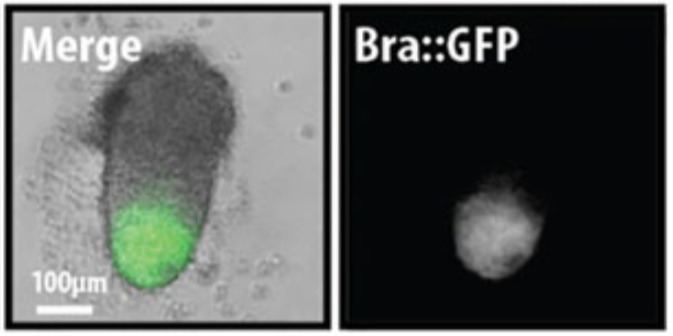 | ||
Gastruloids are three dimensional aggregates of mouse embryonic stem cells (ESCs) that display many features of early development such as symmetry-breaking, axial organisation, germ layer specification, polarised gene expression and axial elongation. As a model system, they are highly reproducible, straightforward to generate and can be used to investigate the underlying principles and processes of early mammalian development.
Background
The Gastruloid model system draws its origins from work by Marikawa et al.. In those studies, small numbers P19 embryonal carcinoma (EC) cells were aggregated as embryoid bodies (EBs) and used to investigate the processes involved in mesoderm formation. Interestingly, the EBs were able to organise themselves into structures similar to the gastrulating embryo with polarised gene expression, axial elongation/organisation and up-regulation of posterior mesodermal markers. This was in stark contrast to work using EBs from mouse ESCs, where this level of organisation had not been reported, even though progenitors of axial populations can be generated in culture.
Following this, and with modifications to the original Marikawa protocol, the Martinez Arias laboratory in the Department of Genetics at the University of Cambridge demonstrated how aggregates of mouse ESCs were able to generate structures that exhibited collective behaviours with striking similarity to those during early development such as symmetry-breaking (in terms of gene expression), axial elongation and germ-layer specification. As noted by the authors of this protocol, a crucial difference between this culture method and previous work with mouse EBs was the use of small numbers of cells which may be important for generating the correct length scale for patterning.
Brachyury (T/Bra), a gene which marks the primitive streak and the site of gastrulation, is up-regulated in the Gastruloids following a pulse of the Wnt/β-Catenin agonist CHIR99021 (Chi; other factors have also been tested) and becomes regionalised to the elongating tip of the Gastruloid. From or near the region expressing T/Bra, cells expressing the mesodermal marker tbx6 are extruded from the similar to cells in the gastrulating embryo; it is for this reason that these structures are called Gastruloids.
